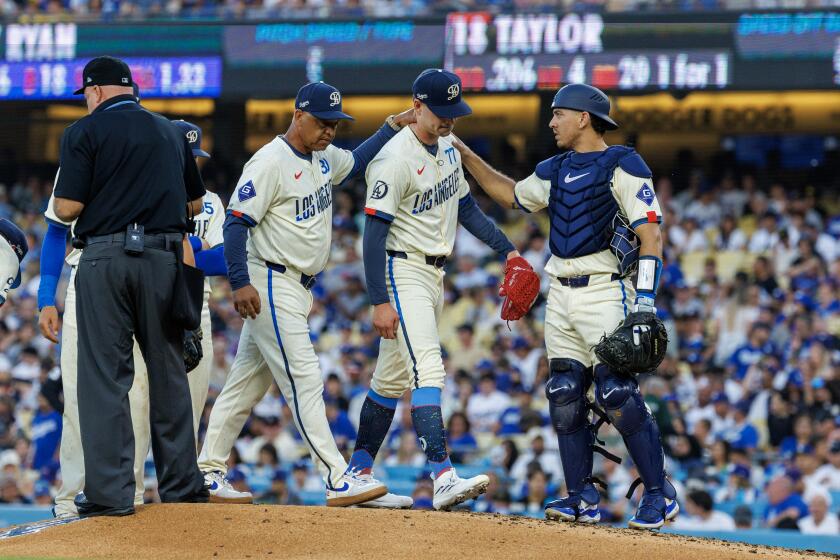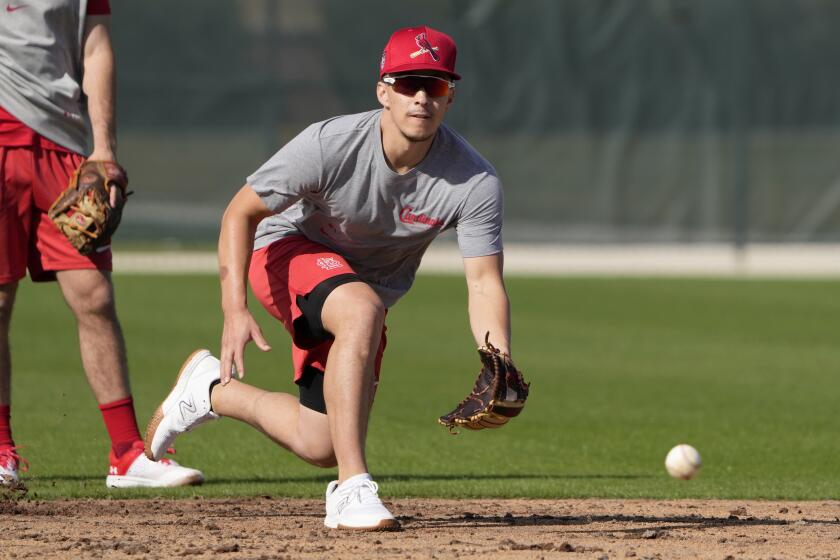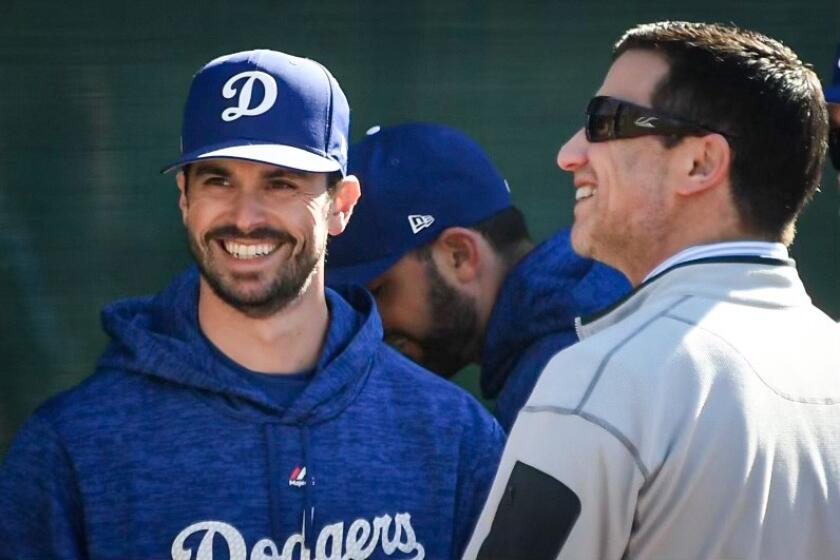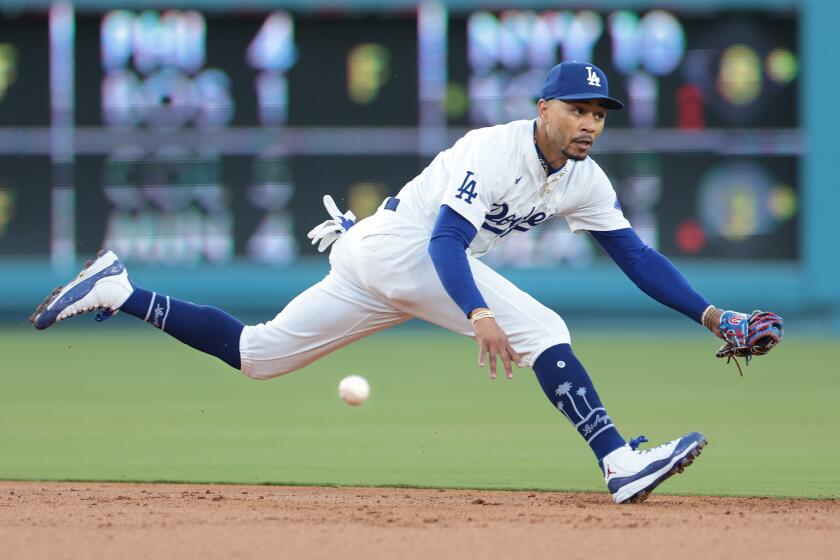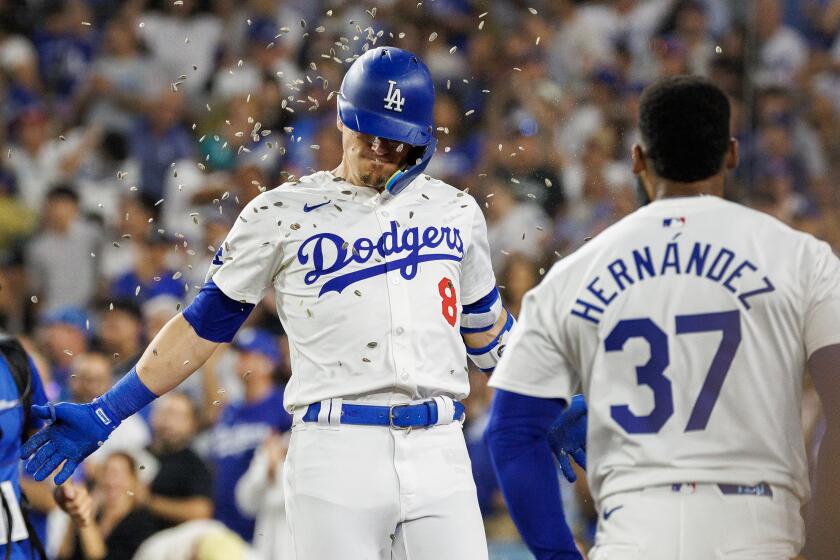
- Share via
At last December’s annual winter meetings in Nashville, Andrew Friedman emerged from a crowded hotel conference room, caught the gaze of an approaching reporter, then pointed to his top lieutenant walking ahead of him.
“You’ve got him today,” Friedman said.
“Him” was Dodgers general manager Brandon Gomes.
And on this day he’d be the voice of the organization.
This was on Dec. 5, after Dodgers manager Dave Roberts revealed to reporters that the team met with then-free agent Shohei Ohtani.
The disclosure surprised the front office — including Friedman, now in his 10th year as president of baseball operations. Given the cloak of secrecy surrounding Ohtani’s free-agent process, team officials were unsure whether it would dent their chances of signing the two-way star.
Dodgers rising pitching star River Ryan suffered a forearm injury during the fifth inning of his fourth career start Saturday at Dodger Stadium.
In the eye of that storm, Friedman declined the opportunity to calm the waters himself, or quell rampant speculation.
Instead, it was Gomes, the third-year general manager and homegrown executive, who was at the reins of the organization’s public response.
Make no mistake, the Dodgers’ front office is still very much Friedman’s domain. He has the final say on all key decisions. He’s the one who, when Ohtani finally did sign with the Dodgers a week after the winter meetings, had his name included in the contract’s “key-man” clause.
However, Gomes’ rise in recent years has marked a notable shift in front-office operations, putting the 40-year-old GM in a leading role for contract and trade negotiations, daily communication with the major-league coaching staff and roster, and even most of the front office’s media obligations.
In the past, such responsibilities were largely in Friedman’s purview, both in his early years of reshaping the Dodgers’ front office in his image, and after other teams repeatedly raided his most trusted confidants.
Between 2017 and 2018, Friedman lost his first farm director, Gabe Kapler, his vice president of baseball operations, Alex Anthopoulous, and his first general manager, Farhan Zaidi, to promotions at rival clubs.
Following Zaidi’s exodus, the Dodgers’ GM post remained vacant through 2021.
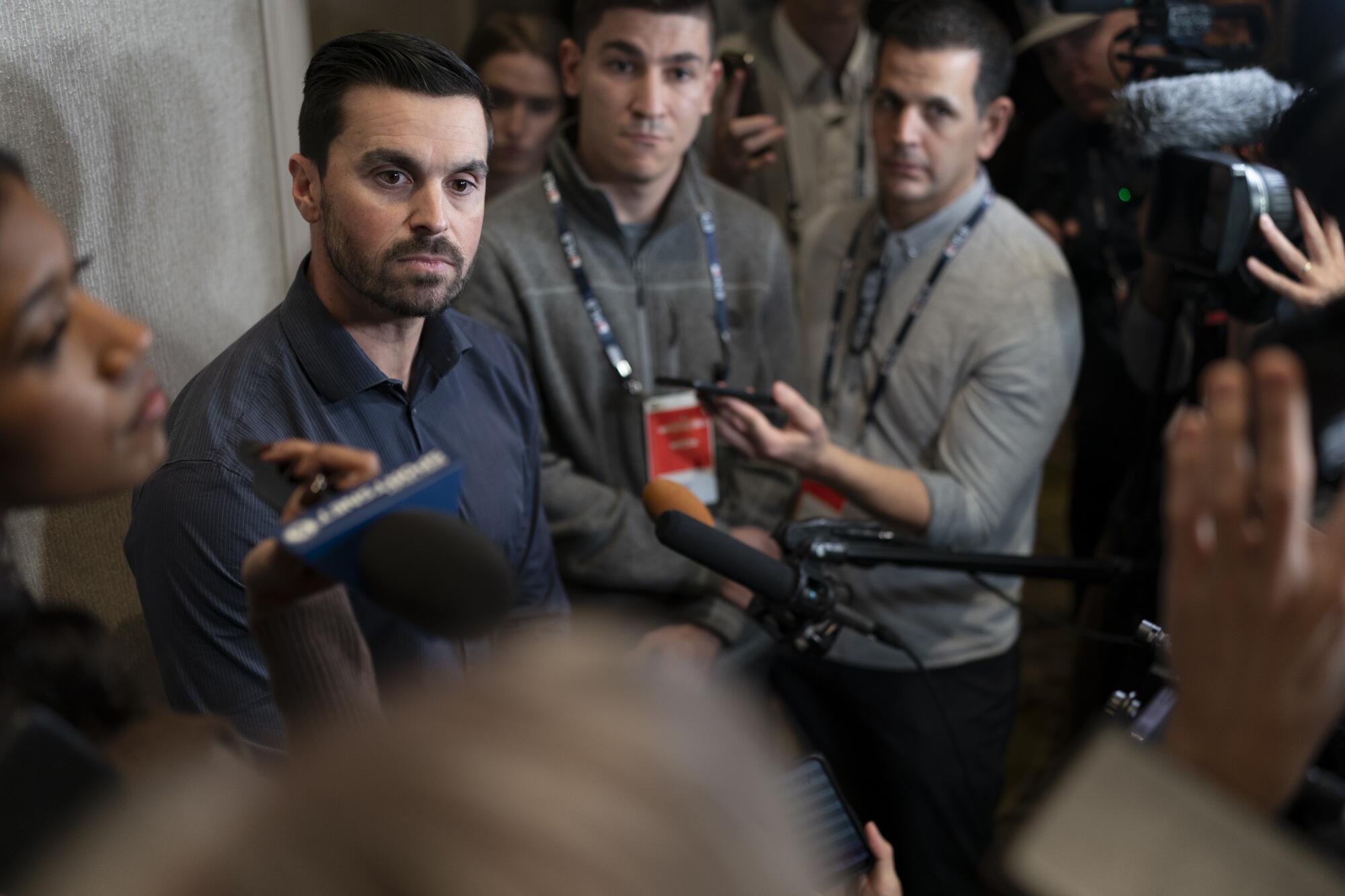
During that time, Friedman spearheaded both big-picture and small-item tasks in the front office — acting as both the club’s composer and conductor.
“He had to do more,” said Jeffrey Kingston, one of the Dodgers’ assistant general managers. “And any time you have to get closer to the weeds, then you lose some more of the big-picture type stuff.”
That’s why, over the last several years, Friedman has bestowed more operational duties to his new cadre of confidants — becoming more of a chief executive who delegates tasks while taking what multiple people around the organization described as a “step back” from some of the day-to-day minutiae.
And it’s why Gomes, who was promoted from pitching coordinator to farm director to assistant GM before assuming his current role at the start of 2022, has particularly become more hands-on.
“It’s allowed us to divide and conquer,” Gomes said of his dynamic with Friedman, as one of nine MLB general managers who report to a president of baseball operations. “You can spend more bandwidth on other things.”
It hasn’t been a flawless process. The Dodgers have built perennial 100-win teams, but struggled to find consistent success in the playoffs. They have one of the most highly touted farm systems in the majors, yet have to spend aggressively (to the tune of almost $1.5 billion last offseason) to fill holes on their roster.
On the whole, though, the Dodgers are still the envy of most rival clubs. They’ve been voted by fellow executives as having baseball’s best front office. And they believe their new structure has produced stability and growth, representing the latest evolution of Friedman’s stint running the team.
“Having good people is everything,” Friedman said. “It’s a massive operation.”
Two days before last month’s trade deadline, one of the Dodgers’ long-coveted trade targets was about to be dealt somewhere else.
For the last several years, the team had tried repeatedly to pry utility man Tommy Edman away from the St. Louis Cardinals.
Then, about 36 hours before the July 30 trade deadline, they got wind the Cardinals were nearing a deal for pitcher Erick Fedde that would send Edman to the Chicago White Sox instead.
So, in one of the more complicated maneuvers any team made this deadline, Gomes got on the phone and wedged the Dodgers into the middle of those trade talks.
“There was a lot of conversation with the White Sox about, ‘Do you think you can get Edman for us?’” Gomes said. “Let’s try to figure this out.”
The Dodgers landed utility man Tommy Edman and relief pitcher Michael Kopech in a three-team trade with the St. Louis Cardinals and the Chicago White Sox.
From there, the framework for a three-team transaction started to emerge, one in which the Dodgers would land Edman and hard-throwing reliever Michael Kopech and the Cardinals would get Fedde and veteran outfielder Tommy Pham.
As negotiations dragged on from Sunday night into Monday morning — the eve of this year’s Tuesday afternoon deadline — Gomes was the one primarily working the phones to get the deal across the finish line.
“A lot of people might have, just on emotion, gotten frustrated and it wouldn’t have happened,” said Alex Slater, another Dodgers assistant general manager. “He was the air traffic controller, and that was a plane that got rerouted like six different times. But he landed the plane. And it was a really important plane to land.”
Indeed, the Dodgers not only got the transaction done — but parted with what was seen as only a relatively light package of prospects.
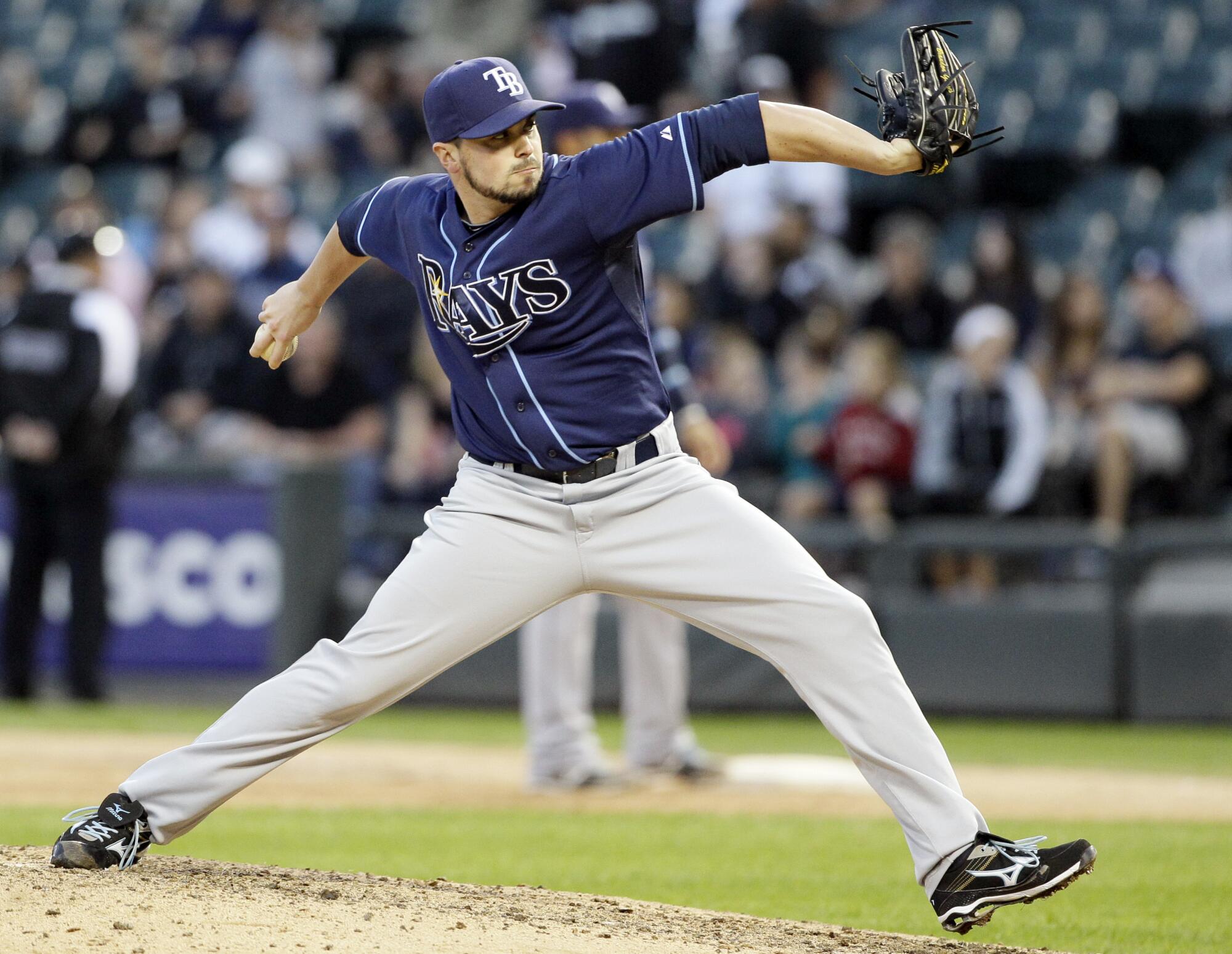
A day later, they made an even bigger deadline splash, acquiring pitcher Jack Flaherty just minutes before the trade market closed.
“It’s very stressful and exhausting,” Gomes said last week, reflecting on the deadline. “But it’s one of the great parts of the job.”
This is the job Gomes began thinking about more than a decade ago, during his five seasons playing for the Friedman-run Tampa Bay Rays.
A crafty right-hander with underwhelming velocity but “super nasty stuff,” as former Rays teammate and current Dodgers outfielder Kevin Kiermaier put it, Gomes was a serviceable big-league reliever, the kind of reliable depth arm (he had a career 4.20 ERA) that Tampa Bay made a habit of developing under Friedman’s leadership.
Still, Gomes went to and from the minor leagues 12 times with the Rays. And with every demotion, his interest in front-office dynamics piqued a little bit more.
Brandon Gomes was sent the minors 12 times during his five-year career with the Tampa Bay Rays. Those trips sparked his interest in front-office operations.
“He would ask questions about procedural stuff, rosters, decision-making — things that most players don’t ask about,” said Rays president of baseball operations Erik Neander, who worked under Friedman during Gomes’ playing days. “He had a genuine curiosity … His level of understanding was pretty significant.”
When Gomes retired in 2016, Friedman was in his second season running the Dodgers, and seeking a pitching coordinator for his minor-league staff. Gomes got the job. His rapid ascent through the Dodgers’ front office had begun.
“I would joke with him, ‘Hey, when you’re done playing, I’m gonna stalk you for us to hire you,’” Friedman said. “But even with those expectations, he’s far exceeded it.”
Gomes’ playing background proved useful in his time as farm director — a job Friedman had “zero expectation” of Gomes getting until he blew team officials away in the interview process.
“I would joke with him, ‘Hey, when you’re done playing, I’m gonna stalk you for us to hire you. But even with those expectations, he’s far exceeded it.”
— Dodgers president Andrew Friedman, on Brandon Gomes
“He was just ridiculous,” Slater recalled. “He had very actionable, first-100-days-on-the-job specifics. Who he’d hire. What he’d change. Things about specific players. It was laid out very clearly.”
Gomes has made a similar impression within the Dodgers’ big-league clubhouse as GM, representing a direct link between the front office and on-field product.
“We talk pretty much every day, and bounce things off each other,” Roberts said. “He has a great way about him, in the sense of how he leads, how he listens, his relationship with the players.”
“In the Ned days, you never saw the front office,” added pitcher Clayton Kershaw, referring to former GM Ned Colletti. “I think Andrew changed that, and Gomer is continuing that. And it’s good. It’s good to interact with that side of it. Not too much. But … if you’re around every day, and you feel like they’re in it with you, you have more of a trust.”
No one, however, has shown more trust in Gomes than Friedman — who has passed myriad responsibilities off to his right-hand man in hopes of creating more “front-office firepower.”
“It takes a little while to develop that cadence,” Friedman said. “But between all of us, I feel like we’ve hit a really nice stride — while appreciating that there’s still a lot of things we can get better.”
The new front-office order does raise two questions about the Dodgers’ future.
Why has Friedman taken a “step back” from some of his old duties? And could the increasing division of labor come with unforeseen limitations?
To Friedman, the answer to the first question assuages concern about the second.
Even after almost two full decades now running the Rays and Dodgers — leaving him with more gray hairs than he once had — the 47-year-old father of three insists he continues to “love what I’m doing.”
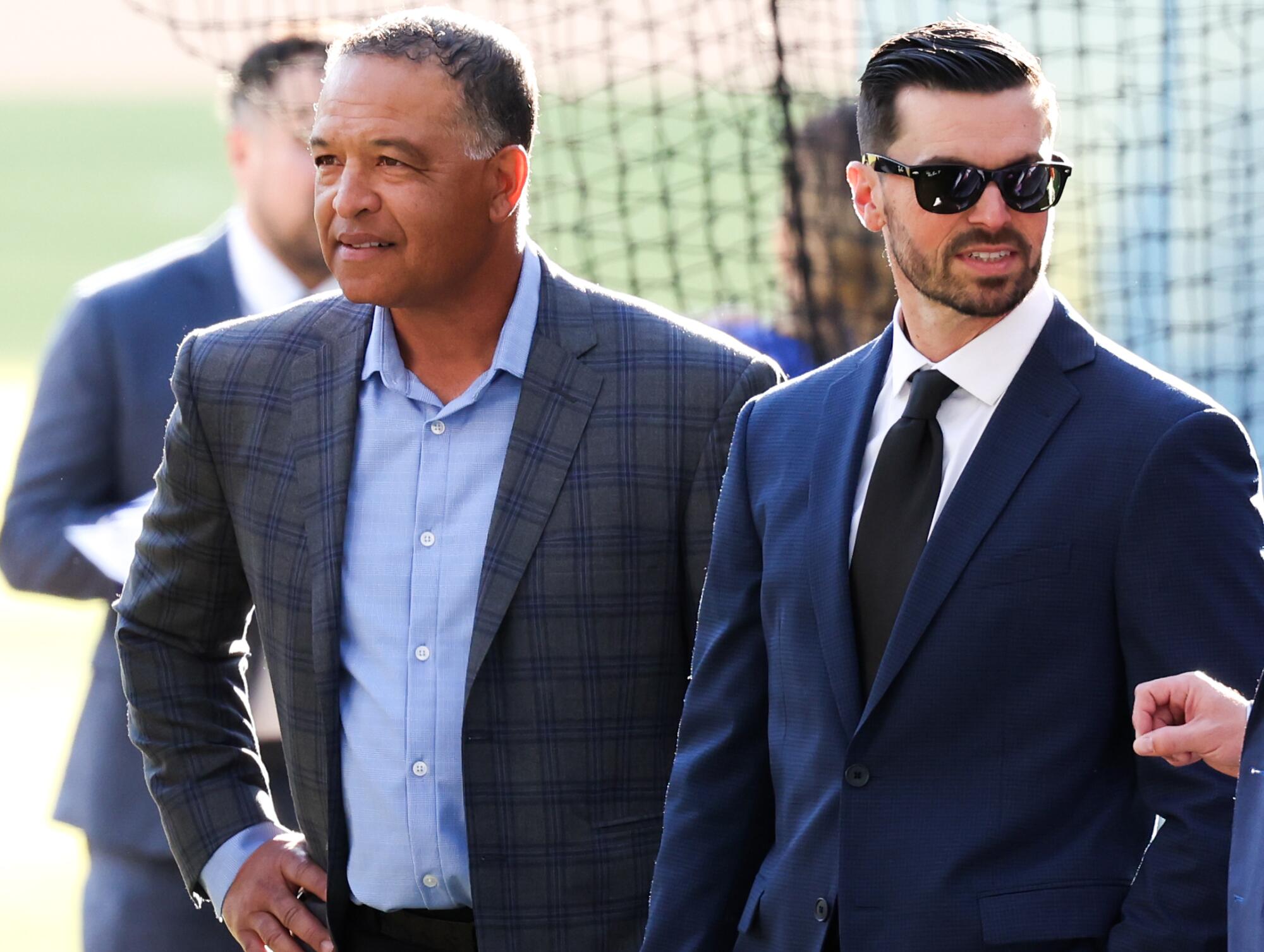
“I hope to be here as far as I can see out,” he said, “and be a part of this incredible group of people that are all highly motivated to win as many World Series as we can.”
To accomplish that, he and club officials pointed to the newfound dynamic in the front office, which they say allows Friedman to mold his club in targeted ways, unburdened by the more tedious tasks that once filled his plate.
Last winter, for example, Friedman curated the free-agent pitches to Ohtani and Yoshinobu Yamamoto and led the charge on Tyler Glasnow’s acquisition and contract extension.
Mookie Betts accepted unprecedented position changes with grace, but Bill Plaschke writes the Dodgers should not push their luck by moving him.
Gomes, meanwhile, went to work on rounding out the rest of the roster. He negotiated the signing of Teoscar Hernández, one of the bigger steals in last winter’s market. He worked on a flurry of smaller trades to balance depth.
“The amount of time that went into Yamamoto, Ohtani, Glasnow was real, but there were a lot of other things that we needed to accomplish,” Friedman said. “So for us to be able to divide and conquer and stay connected with what was going on, allowed each of us to allocate more of our bandwidth to specific things — which increases the chances of it working out favorably.”
People around the team describe the Friedman/Gomes dynamic as more of a subtle handoff than a stark change of approach.
They have a shared emphasis on universal roster-building principles, such as preserving long-term value (the team has a reputation for wanting to “win” every trade, as one rival executive phrased it, even if it means passing on potentially overpriced deals that could address short-term needs) and maximizing the “optionality” of the roster (part of why a versatile defender but average hitter like Edman was so coveted by the club).
They sometimes mirror each other’s in-person’s interactions — from the way they dress (typically, pastel-colored polo shirts and sneakers) to their shared baseball language (notice, both used phrases like “divide and conquer” and maximizing individual “bandwidth”).
“They talk the same, honestly,” Kershaw joked. “Same buzz words.”
It does lead to a third question people inside the organization and around the industry ask, about whether the group is too like-minded when making decisions.
Friedman, after all, has a reputation for being a patient — if not overly cautious — decision-maker. And even as he has delegated more in recent years, the team has continued to operate in that vein.
New Dodgers pitcher Jack Flaherty struggled in his debut at hometown Dodger Stadium, but hitters Shohei Ohtani and Freddie Freeman helped seal a win.
Look at this past offseason when, for all the Dodgers successfully added, they also could have done notably more.
Whatever window the club had to potentially land another long-coveted target, Milwaukee Brewers shortstop Willy Adames, closed by the time they got to spring training — triggering Mookie Betts’ short-notice (and since abandoned) switch to the position.
They also made a last-minute play for Cy Young pitcher Blake Snell in free agency, but were unable to beat out the San Francisco Giants — a missed opportunity that has loomed large over their injury-plagued pitching staff.
There have been missteps at other points as well, from underwhelming trade deadlines in 2022 and 2023, to the failed pursuits of Justin Verlander (in free agency before the 2023 campaign) and Eduardo Rodriguez (who nixed a trade to the Dodgers last season when his agent and Gomes failed to agree on an incentive to get him to waive a no-trade clause).
Each of those decisions had a whiff of long-term risk aversion — a front-office principle of Friedman’s that has drawn criticism from some fans eager to see the team maximize its current championship window.
Behind the scenes, however, club officials counter that narrative, describing a front-office structure that revolves around diversity of thought and philosophical debate.
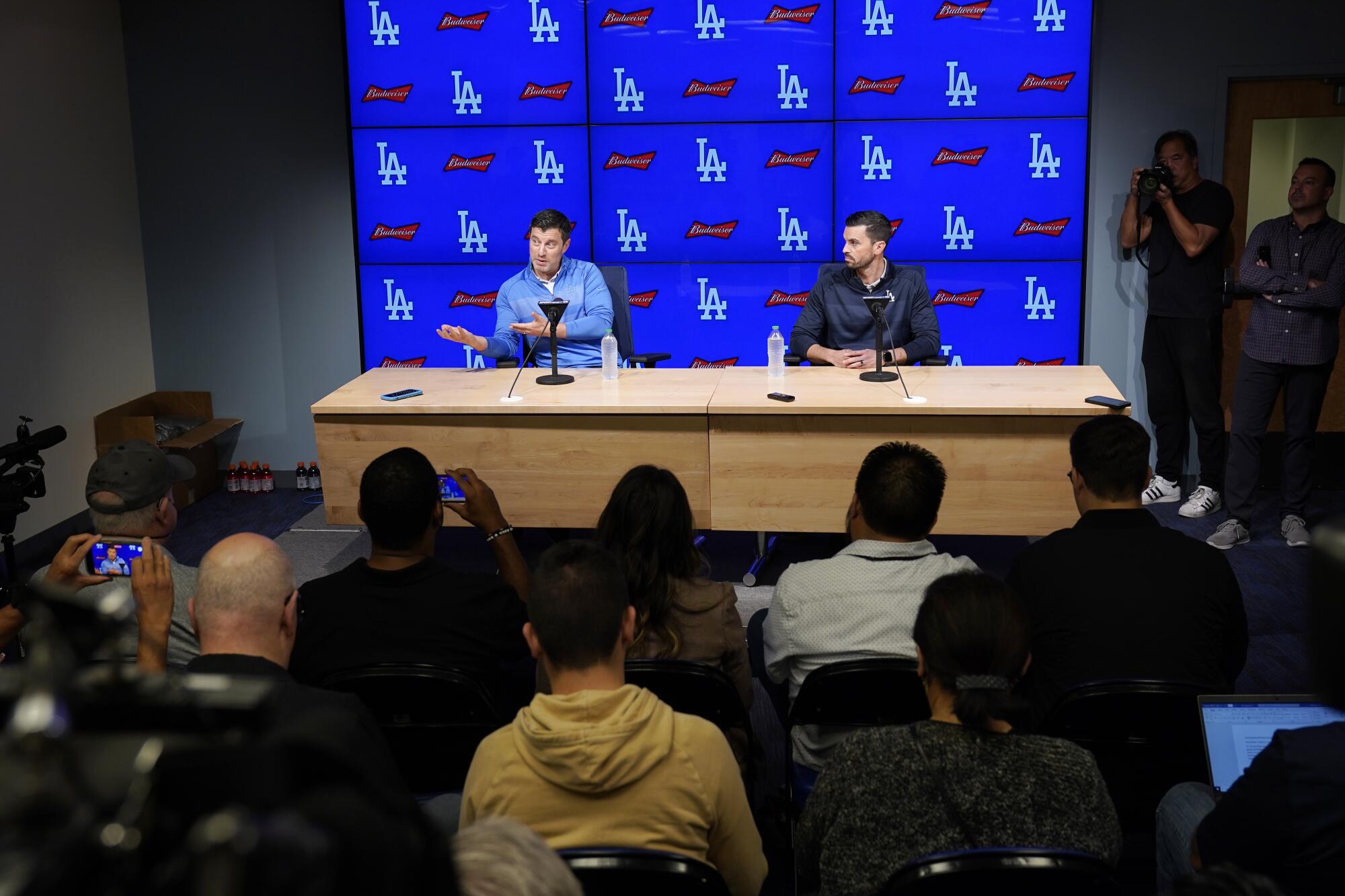
“If we were always all agreeing,” Friedman added, “I would be terrified.”
“Andrew ultimately has the final say,” Slater added. “But he will often not go with what his first instinct is on things.”
It’s an atmosphere Gomes is tasked with continuing to cultivate — responsible for drawing in opinions from different corners of the organization while debating moves with Friedman and other top deputies.
“When him and Andrew debate things directly with each other, I’ve seen a growing confidence in himself and his perspective on things,” Kingston said of Gomes. “He’s not afraid to push back on Andrew and share his thoughts.”
It is one of the key factors members of the front office cited to explain the recent staff stability — even as the Dodgers still field dozens of interview requests from clubs seeking to hire their people.
Mookie Betts was up for the challenge, but he asked the Dodgers to let him switch from shortstop to right field to help the team win. The Dodgers agreed.
Never was that clearer than last October, when Gomes — a Massachusetts native — turned down an interview for the Boston Red Sox’s top front-office position.
Though flattered by the opportunity, and intrigued by the idea of running his own club, Gomes described staying with the Dodgers as an easy decision.
He wasn’t ready to give up the role Friedman had entrusted to him.
“I feel like I have a ton of freedom, I feel like I’m having a large impact on the organization, and still have areas to grow and learn,” Gomes said. “It feels like home, that whole dynamic. I feel like this is a really, really good place for me.”
More to Read
Are you a true-blue fan?
Get our Dodgers Dugout newsletter for insights, news and much more.
You may occasionally receive promotional content from the Los Angeles Times.

